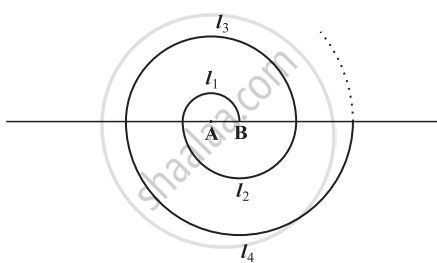Advertisements
Advertisements
प्रश्न
Find the sum of all members from 50 to 250 which divisible by 6 and find t13.
उत्तर
The numbers between 50 to 250 which are divisible by 6 are
54, 60, 66 ....246
Here a = 54, d = 6 and tn = 246
tn = a + (n - 1) d
246 = 54 + (n - 1) (6)
246 - 54 = 6n - 6
192 = 6n - 6
192 + 6 = 6n
6n = 198
n = `198/6`
n = 33
Sn = `"n"/2 [t_1 + t_n"]`
S33 = `33/2 [54 + 246]`
= `33/2 [300]`
S33 = 4950
tn = a + (n - 1) d
t13 = 54 + (13 -1) (6)
= 54 + 12(6)
= 54 + 72
t13 = 126
APPEARS IN
संबंधित प्रश्न
How many terms of the A.P. 18, 16, 14, .... be taken so that their sum is zero?
How many terms of the series 54, 51, 48, …. be taken so that their sum is 513 ? Explain the double answer
How many multiples of 4 lie between 10 and 250?
A spiral is made up of successive semicircles, with centres alternately at A and B, starting with centre at A of radii 0.5, 1.0 cm, 1.5 cm, 2.0 cm, .... as shown in figure. What is the total length of such a spiral made up of thirteen consecutive semicircles? (Take `pi = 22/7`)

[Hint: Length of successive semicircles is l1, l2, l3, l4, ... with centres at A, B, A, B, ... respectively.]
If the ratio of the sum of the first n terms of two A.Ps is (7n + 1) : (4n + 27), then find the ratio of their 9th terms.
The sum of the first n terms of an AP is given by `s_n = ( 3n^2 - n) ` Find its
(i) nth term,
(ii) first term and
(iii) common difference.
Divide 207 in three parts, such that all parts are in A.P. and product of two smaller parts will be 4623.
Find the sum \[7 + 10\frac{1}{2} + 14 + . . . + 84\]
Find the sum of n terms of the series \[\left( 4 - \frac{1}{n} \right) + \left( 4 - \frac{2}{n} \right) + \left( 4 - \frac{3}{n} \right) + . . . . . . . . . .\]
If S1 is the sum of an arithmetic progression of 'n' odd number of terms and S2 the sum of the terms of the series in odd places, then \[\frac{S_1}{S_2} =\]
The sum of first 20 odd natural numbers is
The sum of first 15 terms of an A.P. is 750 and its first term is 15. Find its 20th term.
The sum of all odd integers between 2 and 100 divisible by 3 is ______.
The first term of an AP is –5 and the last term is 45. If the sum of the terms of the AP is 120, then find the number of terms and the common difference.
Find the sum of the integers between 100 and 200 that are not divisible by 9.
The students of a school decided to beautify the school on the Annual Day by fixing colourful flags on the straight passage of the school. They have 27 flags to be fixed at intervals of every 2 m. The flags are stored at the position of the middle most flag. Ruchi was given the responsibility of placing the flags. Ruchi kept her books where the flags were stored. She could carry only one flag at a time. How much distance did she cover in completing this job and returning back to collect her books? What is the maximum distance she travelled carrying a flag?
Complete the following activity to find the 19th term of an A.P. 7, 13, 19, 25, ........ :
Activity:
Given A.P. : 7, 13, 19, 25, ..........
Here first term a = 7; t19 = ?
tn + a + `(square)`d .........(formula)
∴ t19 = 7 + (19 – 1) `square`
∴ t19 = 7 + `square`
∴ t19 = `square`
If the first term of an A.P. is 5, the last term is 15 and the sum of first n terms is 30, then find the value of n.
Find the sum of all 11 terms of an A.P. whose 6th term is 30.
An Arithmetic Progression (A.P.) has 3 as its first term. The sum of the first 8 terms is twice the sum of the first 5 terms. Find the common difference of the A.P.
